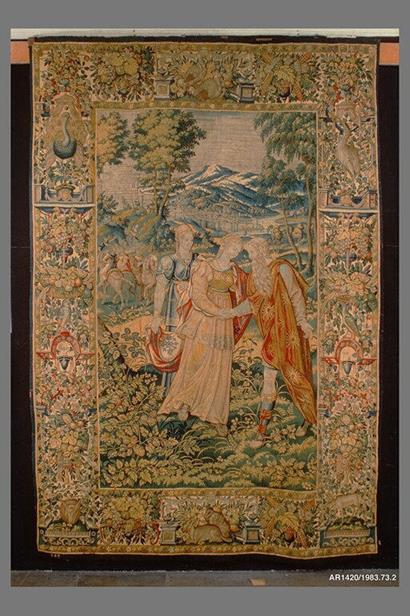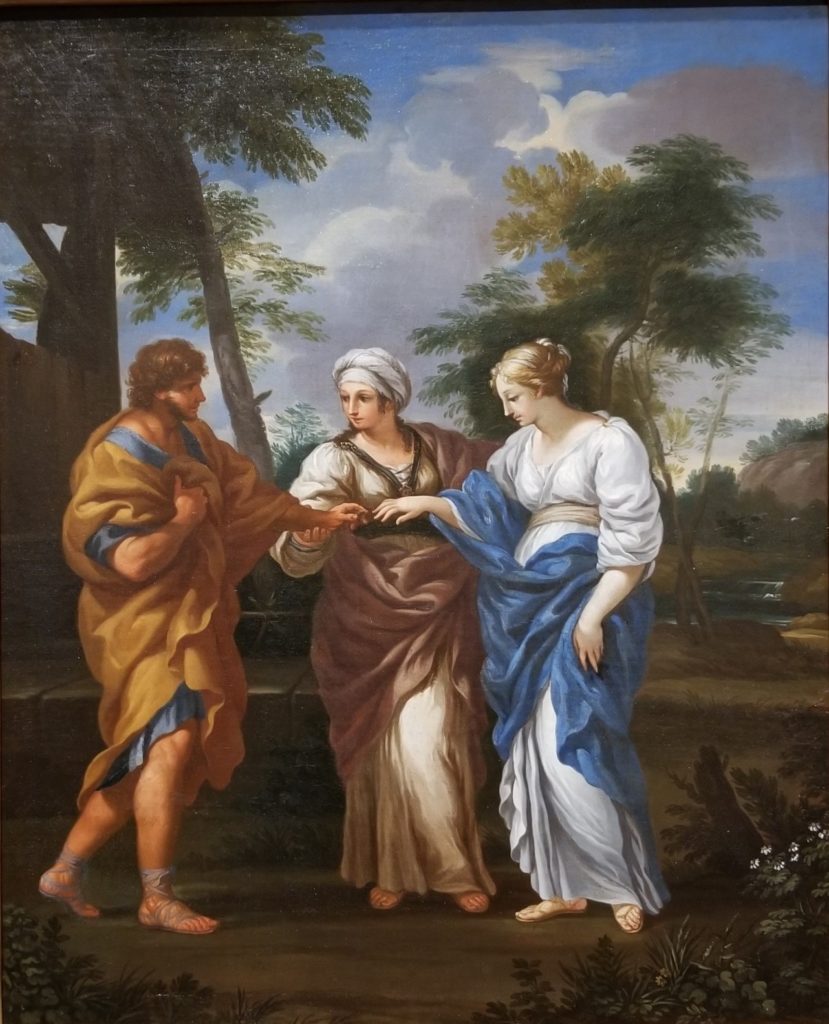Reading the Torah, sometimes, can give a false impression of reading a story, albeit the greatest story ever written. This Divine drama involves colorful characters, sophisticated plots, jealousy, sibling rivalry, deception, struggle, suffering, and every human emotion.
The profound insight brought to light by the Kabbalah—the esoteric interpretation of Torah—was the realization that the human drama played out by Biblical characters is also a mashal—a metaphor or an allegory—that alludes to spiritual forces interacting in higher worlds. Actually, from the point of view of Jewish mysticism, whatever happens down here, first takes place in the spiritual worlds and only later[1] manifests itself in the physical realm. Every Biblical hero, from the point of view of the Kabbalah, is an embodiment and personification of a supernal spiritual archetype.
Thus, physical Abraham, in the Kabbalah mysticism, is an embodiment of the sefirah of Chesed—the Divine attribute of loving kindness; Isaac is a personification of the sefirah of Gevurah—the Divine attribute of strength, severity and judgment. Jacob is the personification of the sefirah of Tiferet—the Divine attribute of beauty, mercy, and harmony. He is also viewed as an earthly embodiment of the spiritual construct called partzuf Zeer Anpin (Z”A)—configuration of a “small visage.”[2] The sisters, our matriarchs Leah and Rachel, are personifications of two minor partzufim—Partzuf Leah and Partzuf Rachel respectively, which are two aspects of the Nukva d’Z”A—the “mate” of the Zeer Anpin.[3] Because in spiritual worlds Partzuf Leah and Partzuf Rachel ”couple,” that is, interact, with the Z”A in the spiritual words, in the physical world, two sisters are married to Jacob, who is the physical embodiment of the Z”A.
Thus, every Biblical story is read in the Kabbalah as an allegory to a spiritual dynamics unfolding in higher realms (in addition, of course, to its literal meaning). In other words, according to the Kabbalah, Biblical stories also teach us about the spiritual laws.
It seems, however, that Torah also contains profound allegories to fundamental laws of nature. The Midrash says, G‑d looked in the Torah and created the world (Midrash Raba, Gen. 1:1). The Torah, therefore, can be seen, inter alia, as the blueprint of the physical world. It is no surprise, therefore, that the Torah should teach us about nature. Reading the Torah portion Vayetze, reminds us of an old lesson in physical chemistry.
In the chapter, Jacob’s Ladder, we discussed how Jacob’s dream hints at the atomic structure of matter. To continue this topic further, let us recall that an atom is comprised of a positively charged nucleus surrounded by negatively charged electrons “orbiting” the nucleus on discrete elliptical orbitals. According to the laws of quantum mechanics, every orbit or shell can be populated by a certain number of electrons. For example, the first innermost orbit can have only two electrons, the second shell can have eight electrons, and so on. Electrons populating the outermost shell are the ones that mostly determine the chemical properties of the atom, because chemical reactions are driven by electrical forces acting between atoms, which are mostly due to electrons on the outermost shell of the atom. Usually an atom is neutral, because the number of negatively-charged electrons is exactly equal to the positively charged protons in the atom’s nucleus. However, if an atom has extra electrons on the outermost shell it will be negatively charged. Such atoms are called negative ions. If the outermost shell is missing a few electrons, the atom will be positively charged. Such atoms are called positive ions.
Some atoms easily “lend” or “borrow” their electrons to or from other nearby atoms forming ions as they try to fill their outer shell, thereby attaining more stability. Sodium, for example, has one electron in its outer shell and will happily give it up to another atom to have a full shell, which is the shell below. From the point of view of quantum mechanics, when two atoms are close together, the electrons on the outer shell may distribute themselves over two atoms to create most stable configuration.
Metals are particularly known to easily give up their electrons (which is why they are such good conductors). Nonmetal elements are happy to borrow electrons from others. The element most likely to borrow electrons is chlorine (Cl). Compounds formed by the transfer of electrons from one atom to another are said to be electrovalent, and electrons, which can be borrowed, are called valence electrons. These electrons create bonds between atoms.
Take, for example, sodium chloride (NaCl)—regular table salt. An atom of chloride (Cl) receives its eight electrons (positioned on the outer shell) from the nearby atom of sodium (Na), which donates its outmost electrons and retracts to the lower stable orbit.
What does this all have to do with the Torah portion we are discussing? Let’s read the following dialog from this Torah portion:
And Rachel saw that she borne Jacob no children, Rachel envied her sister; and she said unto Jacob, “Give me children, or else I die.” And Jacob’s anger was kindled against Rachel; and he said, “Am I in G‑d’s stead, who hath withheld from thee the fruit of the womb?” (Genesis 30:1-2)
The Ari explains this seemingly simple dialog as follows: Jacob reveals to his wife, Rachel, that her infertility is due to the lack of the letter Heh in her name. Jacobs’s grandparents, Abraham and Sarah, were originally called Abram and Sarai. They had been barren until G‑d added letter the Heh to their names changing them respectively to Abraham and Sarah. Jacob’s mother, Rebecca (Rivkah) had the letter Heh (h) in her name and so did Jacob’s other wife, Leah. Only Rachel among all Jewish matriarchs was missing the letter Heh.
The letter Heh is seen as the essence of femininity. In Hebrew grammar, nouns ending with the letter Heh are usually of feminine gender. In Kabbalah, this letter Heh signifies the sephirah-emanation of Malchut, which is the ultimate feminine archetype. Lacking the feminine letter Heh, Rachel was unable to bear children. According to the Ari, this mystery is hinted at in the above verse. The phrase “Am I instead of G‑d?” in Hebrew reads hatachat Elo-him Anochi? The numerical value (gematriah) of the Divine name, Elo-him, is 86.[4] The numerical value of the word “Anochi” (“I”) is 81.[5] By stating emphatically that he is not G‑d (Am I in G‑d’s stead?!) Jacob hints to Rachel on the missing letter Heh whose gematriah is 5: 86 – 81 = 5.
Jacob further hints to Rachel that the solution is in her maidservant, Bilhah, who has two letters Heh in her name—Bilhah—one for Rachel and one for herself. All Rachel needed to do was to borrow this letter Heh from Bilhah and they would both conceive. Rachel gets the message as we read in the very next verse:
And she said, “Behold my maid Bilhah, go in unto her; that she may bear upon my knees, and I also may be builded up through her.” (Genesis 30:3)
Indeed, Bilhah soon conceives:
And she gave him Bilhah her handmaid to wife; and Jacob went in unto her. And Bilhah conceived, and bore Jacob a son. (Genesis 30:4-5)
And then Rachel conceives as well:
And G‑d remembered Rachel, and G‑d hearkened to her, and opened her womb. (Genesis 30:22)
Thus far is the Ari. To summarize this interpretation, Rachel was missing the letter Heh in her name, while her maidservant Bilhah had an extra letter Heh. As a consequence, both were barren. Redistributing the extra letter Heh from Bilhah to Rachel (both closely related as twin sisters, according to Midrash Seder Olam, or, at least as half-sisters, according to Midrash Raba on Genesis 74:14) allowed them both to conceive. Two barren women were healed by redistributing an extra letter between their respective names.[6]
Now, let us compare this narrative to two elements, one missing five (recall that the numerical value of the letter Heh is five) electrons on its outer shell and the other having five extra electrons on its outer shell, both being in unstable (“unhealthy”) state. Being close together allows them redistribute extra electrons that both elements achieving stable (“healthy”) state.
Interestingly, the root of Chloride (the element most likely to borrow electrons) is “chlor.”[7] Spelled in Hebrew letters, it is Chet, Lamed and Resh—the same letters that spell the name Rachel. Is this a coincidence? Perhaps.
Let us also recall that metals usually donate their electrons. “Barzel” (iron or metal in Hebrew) is also an acronym for Jacob’s four wives: Bilhah, Rachel, Zilpah, and Leah–BaRZeL. Another coincidence? Maybe. You be the judge.
———————
Endnotes:
[1] The word “later” is used here not in a temporal sense but rather in a sense of hierarchical order of the ontological order of creation—seder hishtalshelut—the chainlike order of unfolding of creation, in which “later” also means “lower.”
[2] Zeer Anpin (Z”A) is a partzuf constructed of the six sefirot—Chesed, Gevurah, Tiferet, Netzach, Hod, and Yesod. Sometimes, the Z”A is also called Microprosopus.
[3] Nukva is identified with the Shechinah and represents the female principle in the Divine.
[4] Elo-him is spelled Alef-Lamed-Heh-Yud-Mem. Each Hebrew letter has a numerical value (gematriah). Thus, Alef = 1, Lamed = 30, Heh = 5, Yud = 10, Mem = 40. 1 + 30 + 5 + 10 + 40 = 86.
[5] Anochi is spelled Alef-Nun-Chof-Yud. Alef = 1, Nun = 50, Chof = 20, Yud = 10. 1 + 50 + 20 + 10 = 81.
[6] Actually, no change in their names occurred (unlike the name of Abram and Sarai that were changed to Avraham and Sarah). Being Rachel’s handmade, Bilhah belonged to her and, therefore, her name, as it were, belonged to Rachel as well. Rachel only needed to realize that and give Bilhah to Jacob to achieve this effect.
[7] The name of this element is “chlorine”, from the Greek word χλωρος (chlōros, “green-yellow”).



Wow! Can’t believe that I’ve never seen your site before!! Amazing stuff…looking forward to the infinite conversation.
Asher